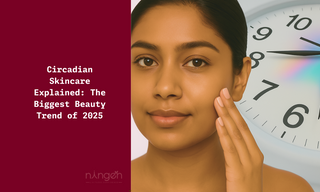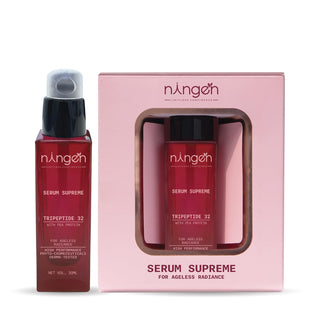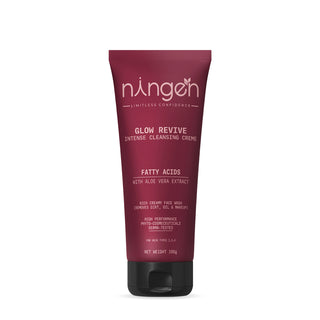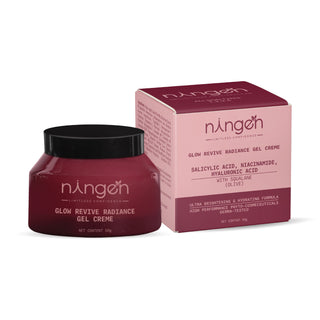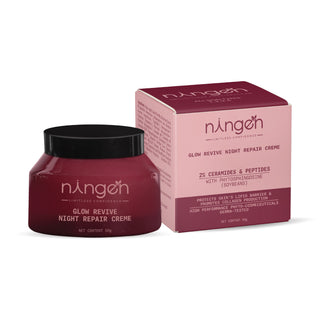Last Updated: June 2025 | Reading Time: 12 minutes
Your skin operates on its own internal clock, and understanding this natural rhythm could revolutionize your beauty routine. Welcome to the world of circadian skincare, where science meets self-care in the most sophisticated way possible.
TL;DR
Your skin follows a 24-hour cycle: mornings are for protection (vitamin C, moisturizer, SPF), evenings for active treatments (AHAs, serums), and nights for repair (retinoids, rich creams). Science shows skin cell renewal peaks at night (3x higher than daytime) while barrier protection is strongest during the day, making nighttime the optimal window for anti-aging actives and morning ideal for antioxidants and sun protection. Expect texture improvements in 2-4 weeks and significant changes in 8-12 weeks with consistent timing.
In this Guide;
What Is Circadian Skincare? The Science Behind Your Skin's Clock
Your Skin's 24-Hour Schedule: What Happens When
The Science: Key Studies and Research Findings
Building Your Circadian Skincare Routine: The Complete Guide
Advanced Circadian Skincare Strategies
Ingredient Deep Dive: The Science Behind Circadian Actives
The Future of Circadian Skincare: What's Coming Next
What Is Circadian Skincare? The Science Behind Your Skin's Clock
Circadian skincare is a smart way of caring for your skin based on its natural 24-hour cycle—just like how your body has a clock that controls sleep and energy, your skin has one too.
During the day, your skin focuses on protection—fighting off pollution, UV rays, and stress. At night, it switches to repair mode—healing, renewing cells, and building strength.
This isn’t just a trend. Research in the Journal of Investigative Dermatology shows that skin works differently at different times of the day. For example, skin cells grow and renew faster at night, while your skin’s barrier is strongest during the day.
By syncing your skincare routine with this rhythm, you can get better results, like glowing, healthy skin that works with you, not against you.
Also read: Circadian rhythm and skin health.
The Discovery: How Scientists Uncovered Skin's Internal Clock
In 2017, the Nobel Prize in Physiology was awarded to researchers who discovered circadian rhythms at the cellular level. This breakthrough revealed that skin cells contain their own molecular clocks, controlled by specific genes called "clock genes" (CLOCK, BMAL1, PER, and CRY genes).
Your Skin's 24-Hour Schedule: What Happens When
Understanding your skin's natural schedule is crucial for maximizing your skincare routine's effectiveness. Here's what happens throughout the day:
Morning (6 AM - 12 PM): Defense Mode Activated
-
Cortisol levels peak, reducing inflammation
-
Sebum production increases to protect against environmental damage
-
Antioxidant activity heightens to combat free radicals
-
Skin temperature rises, improving circulation
Afternoon (12 PM - 6 PM): Peak Protection
-
Maximum barrier function against UV damage and pollution
-
Lowest skin permeability (products penetrate less effectively)
-
Highest sebum production of the day
-
Optimal time for sun protection application
Evening (6 PM - 12 AM): Transition Period
-
Stress hormone levels begin dropping
-
Skin temperature starts to decline
-
Preparation for nighttime repair mode
-
Increased receptivity to skincare products
Night (12 AM - 6 AM): Repair and Renewal
-
Peak cell division and regeneration (3x higher than daytime)
-
Maximum skin permeability for product absorption
-
Increased blood flow to skin tissues
-
Collagen synthesis peaks around 1-3 AM
-
Growth hormone release supports skin repair

The Science: Key Studies and Research Findings
Landmark Studies in Chronobiology
Research from Harvard Medical School and the University of Manchester has provided compelling evidence for circadian skincare:
-
Cell Division Study (2019): Skin cell mitosis peaks between 12 AM and 4 AM, with rates 3x higher than during daytime hours.
-
Permeability Research (2020): Transepidermal water loss (TEWL) increases by 25-30% during nighttime hours, indicating higher product absorption potential.
-
Collagen Synthesis Study (2021): Fibroblast activity and collagen production show distinct circadian patterns, with peak synthesis occurring between 1-3 AM.
The Molecular Mechanisms
Your skin's circadian rhythm is controlled by:
-
Clock genes that regulate cellular timing
-
Circadian transcription factors that control gene expression
-
Metabolic oscillators that influence cellular energy
-
Hormone fluctuations (cortisol, melatonin, growth hormone)
Building Your Circadian Skincare Routine: The Complete Guide
Morning Routine (6 AM - 10 AM): Protect and Energize
Step 1: Gentle Cleansing
-
Use mild, pH-balanced cleansers
-
Avoid over-cleansing as sebum production is naturally higher
-
Best ingredients: Gentle surfactants, ceramides
Step 2: Antioxidant Application
-
Apply vitamin C serums for maximum free radical protection
-
Optimal concentration: 10-20% L-ascorbic acid or stable derivatives
-
Timing matters: Apply 15-20 minutes before sunscreen
Step 3: Hydration and Barrier Support
-
Use lightweight, fast-absorbing moisturizers
-
Key ingredients: Hyaluronic acid, niacinamide, peptides
Step 4: Sun Protection
-
Apply broad-spectrum SPF 30+ as the final step
-
Pro tip: Reapply every 2 hours for optimal protection
Evening Routine (6 PM - 10 PM): Prep for Repair
Step 1: Deep Cleansing
-
Remove makeup, sunscreen, and daily pollutants
-
Double cleansing method: Oil cleanser followed by water-based cleanser
Step 2: Active Ingredients
-
This is when your skin is most receptive to treatments
-
Best time for: AHAs, BHAs, retinoids, peptides
-
Application tip: Wait 20-30 minutes between active ingredients
Step 3: Targeted Treatments
-
Apply serums addressing specific concerns
-
High-penetration window: 7 PM - 9 PM optimal timing
Night Routine (10 PM - 12 AM): Maximize Repair
Step 1: Rich Moisturization
-
Use heavier, more occlusive formulas
-
Key ingredients: Ceramides, squalane, peptides, growth factors
Step 2: Overnight Treatments
-
Apply sleeping masks or overnight serums
-
Best ingredients for night: Retinoids, bakuchiol, peptide complexes
Step 3: Eye and Lip Care
-
Use targeted treatments for delicate areas
-
Night-specific benefits: Increased absorption, longer contact time
Ingredient Timing: What to Use Whe
Morning Champions: Protective Ingredients
Vitamin C (L-Ascorbic Acid)
-
Optimal timing: 7-8 AM
-
Concentration: 10-20%
-
Why morning: Enhances sun protection, neutralizes free radicals
-
Synergy: Pairs perfectly with SPF for enhanced protection
Niacinamide
-
Optimal timing: Any time, but particularly effective in AM
-
Concentration: 5-10%
-
Benefits: Reduces sebum production, minimizes pores, anti-inflammatory
Hyaluronic Acid
-
Optimal timing: Both AM and PM
-
Molecular weight: Mix of high and low for optimal penetration
-
Application: On damp skin for maximum hydration
Evening All-Stars: Repair Ingredients
Retinoids (Retinol, Retinyl Palmitate, Prescription Tretinoin)
-
Optimal timing: 8-10 PM
-
Why evening: Photosensitive, peak cell turnover alignment
-
Start slow: 2-3 times per week, gradually increase
-
Pro tip: Apply to completely dry skin
Alpha Hydroxy Acids (AHAs)
-
Best types: Glycolic acid, lactic acid, mandelic acid
-
Optimal timing: Evening only
-
Concentration: Start with 5-10%, progress to 15-20%
-
Frequency: 2-3 times per week maximum
Peptides
-
Optimal timing: Evening (higher absorption)
-
Types: Signal peptides, carrier peptides, neurotransmitter peptides
-
Benefits: Stimulate collagen production, improve elasticity
Bakuchiol (Natural Retinol Alternative)
-
Optimal timing: Evening preferred, can use AM
-
Concentration: 0.5-2%
-
Benefits: Retinol-like effects without photosensitivity
Also read: The benefits of using circadian rhythm serum

Advanced Circadian Skincare Strategies
Skin Cycling: The 4-Night Method
Popularized by dermatologist Dr. Andrea Suarez, skin cycling aligns with your skin's natural repair cycle:
Night 1: Exfoliation
-
Use AHA or BHA products
-
Focus on removing dead skin cells
Night 2: Retinoid
-
Apply retinol or prescription retinoids
-
Support cellular renewal
Night 3 & 4: Recovery
-
Focus on hydration and barrier repair
-
Use gentle, nourishing ingredients
Seasonal Circadian Adjustments
Spring/Summer Modifications:
-
Increase antioxidant concentration
-
Lighter evening moisturizers
-
Enhanced sun protection
-
Higher frequency of exfoliation
Fall/Winter Adaptations:
-
Richer night treatments
-
Increased barrier support
-
Lower retinoid frequency
-
Added humectants and occlusives
Technology Integration: Smart Skincare for the Digital Age
Circadian-Tracking Apps and Devices
Modern technology can help optimize your circadian skincare routine:
Light Exposure Tracking:
-
Apps like "Light Meter" help monitor daily light exposure
-
Blue light exposure trackers for evening routine timing
Sleep Quality Monitors:
-
Wearable devices that track sleep stages
-
Correlation between sleep quality and skin appearance
Environmental Sensors:
-
Air quality monitors for adjusting protective routines
-
UV index trackers for daily sun protection needs
AI-Powered Personalization
Emerging technologies offer personalized circadian skincare recommendations:
-
Genetic testing for circadian gene variants
-
Skin analysis apps that adjust recommendations by time of day
-
Smart mirrors with circadian lighting
Ingredient Deep Dive: The Science Behind Circadian Actives
Chronocosmetic Ingredients: The New Frontier
Chronopeptides:
-
Example: Chronogen (mimics natural cellular timing)
-
Application: Evening for maximum effectiveness
Circadian-Responsive Antioxidants:
-
Ergothioneine: Provides 24-hour antioxidant protection
-
Resveratrol: Activates SIRT1 genes involved in circadian regulation
-
Coenzyme Q10: Supports cellular energy production cycles
Time-Released Formulations:
-
Encapsulated actives that release ingredients over time
-
Benefits: Sustained delivery aligned with skin needs
-
Technologies: Liposomal delivery, microsphere encapsulation
Note: Read about Tripeptide-32, a chronopeptide that works with circadian rhythm.
Natural Circadian Enhancers
Melatonin in Skincare:
-
Function: Powerful antioxidant, supports cellular repair
-
Application timing: Evening only
-
Concentration: 0.1-1% effective range
-
Research: Studies show improved skin elasticity and reduced wrinkles
Plant-Based Chronobiotics:
-
Ginseng: Supports cellular energy and repair cycles
-
Green tea extract: Provides circadian-aligned antioxidant protection
-
Centella asiatica: Supports nighttime skin barrier repair

The Future of Circadian Skincare: What's Coming Next
Emerging Research Areas
Microbiome and Circadian Rhythms:
-
Research shows skin microbiome follows circadian patterns
-
Future products may target specific bacterial populations by time of day
-
Probiotic skincare with time-release capabilities
Personalized Circadian Profiles:
-
Genetic testing for individual circadian gene variants
-
Customized product formulations based on personal chronotypes
-
AI-driven routine optimization
Smart Formulations:
-
pH-responsive ingredients that activate based on skin's natural pH cycles
-
Temperature-sensitive formulations that respond to skin temperature changes
-
Light-activated ingredients for daytime protection
Industry Innovations
Packaging Advances:
-
Time-sensitive packaging that changes color or texture
-
Dual-chamber systems for AM/PM formulations
-
Smart dispensers that adjust product amounts by time of day
Professional Treatments:
-
Spa treatments timed to circadian rhythms
-
LED light therapy aligned with natural skin cycles
-
Professional peels scheduled for optimal recovery timing
Common Mistakes to Avoid in Circadian Skincare
Timing Errors That Sabotage Results
Using Photosensitizing Ingredients During the Day:
-
Mistake: Applying AHAs, retinoids, or essential oils in AM
-
Solution: Reserve these for evening use only
-
Why it matters: Increases sun sensitivity and potential for irritation
Over-Cleansing in the Morning:
-
Mistake: Using harsh cleansers when sebum production is protective
-
Solution: Gentle cleansing or just water in AM
-
Impact: Disrupts natural barrier function
Skipping Evening Cleansing:
-
Mistake: Not removing daily buildup before sleep
-
Solution: Double cleanse to prepare skin for repair mode
-
Consequence: Impaired overnight absorption and repair
Product Combination Errors
Layering Conflicts:
-
Mistake: Combining acids with retinoids in same routine
-
Solution: Alternate nights or separate by several hours
-
Risk: Increased irritation and reduced effectiveness
pH Incompatibilities:
-
Mistake: Using vitamin C with high pH products immediately after
-
Solution: Wait 15-20 minutes between applications
-
Science: pH differences can neutralize active ingredients
Measuring Success: How to Track Your Circadian Skincare Results
Objective Measurements
Skin Hydration Tracking:
-
Use hydration meters weekly at consistent times
-
Track improvements in barrier function
-
Expected timeline: 2-4 weeks for noticeable changes
Photo Documentation:
-
Take photos at same time daily (preferably morning natural light)
-
Focus on specific concerns (pores, texture, pigmentation)
-
Tracking frequency: Weekly for 12 weeks minimum
Sleep Quality Correlation:
-
Monitor how sleep quality affects skin appearance
-
Use sleep tracking apps or devices
-
Key insight: Better sleep often correlates with better skincare results
Subjective Assessments
Texture and Feel:
-
Daily assessment of skin smoothness and softness
-
Note changes in product absorption rates
-
Track any sensitivity or irritation patterns
Appearance Improvements:
-
Monitor brightness and radiance changes
-
Assess pore appearance and skin clarity
-
Document any changes in fine lines or elasticity
Professional Guidance: When to Consult a Dermatologist
Signs You Need Professional Help
Persistent Issues Despite Routine Optimization:
-
Continued acne or skin concerns after 8-12 weeks
-
Unusual reactions to time-based routines
-
Skin conditions that worsen with circadian approach
Customization Needs:
-
Complex skin conditions requiring medical intervention
-
Prescription retinoid integration
-
Professional treatment timing optimization
Monitoring Requirements:
-
Tracking results with professional-grade equipment
-
Adjusting routines based on seasonal or hormonal changes
-
Long-term skin health planning
Circadian Skincare for Different Skin Types and Concerns
Acne-Prone Skin
Morning Focus:
-
Gentle cleansing to preserve protective sebum
-
Salicylic acid for oil control
-
Non-comedogenic sunscreen
Evening Protocol:
-
Deep cleansing to remove excess oil and debris
-
Benzoyl peroxide or retinoids for treatment
-
Lightweight, non-occlusive moisturizer
Timing Optimization:
-
Tretinoin application: 9-10 PM for maximum effectiveness
-
BHA application: Early evening (6-7 PM)
-
Recovery nights: Focus on barrier repair and hydration
Aging/Anti-Aging Concerns
Morning Strategy:
-
Antioxidant serums (vitamin C, E, ferulic acid)
-
Peptide treatments for ongoing repair
-
Broad-spectrum sun protection
Evening Approach:
-
Retinoid treatments for cellular renewal
-
Growth factor serums
-
Rich, reparative moisturizers
Key Timing:
-
Retinoids: 8-10 PM (align with peak repair time)
-
Peptides: Can be used AM or PM, PM preferred for penetration
-
AHAs: 2-3 evenings per week maximum
Sensitive Skin
Gentle Morning Routine:
-
Mild, fragrance-free cleansers
-
Soothing ingredients (ceramides, centella asiatica)
-
Mineral sunscreens
Careful Evening Protocol:
-
Ultra-gentle cleansing
-
Barrier-supporting ingredients
-
Minimal active ingredients, introduced slowly
Special Considerations:
-
Longer adjustment periods for new ingredients
-
More recovery nights in cycling routines
-
Focus on hydration and barrier function
Hyperpigmentation
Morning Defense:
-
Vitamin C for antioxidant protection
-
Niacinamide for inflammation control
-
Strict sun protection
Evening Treatment:
-
Gentle exfoliation (AHAs 2-3x weekly)
-
Hydroquinone or kojic acid (if tolerated)
-
Retinoids for cellular turnover
Long-term Strategy:
-
Consistent sun protection is crucial
-
Patient approach with gentle, sustained treatment
-
Professional treatments may be needed for stubborn spots
The Economics of Circadian Skincare: Investment vs. Results
Cost-Benefit Analysis
Initial Investment:
-
Quality AM/PM specific products: $150-400
-
Professional consultation: $200-500
-
Tracking tools and apps: $0-100
Long-term Savings:
-
Reduced need for professional treatments
-
More effective use of existing products
-
Prevention of future skin damage
ROI Timeline:
-
Month 1-2: Adjustment period, minimal visible changes
-
Month 3-4: Noticeable improvements in texture and hydration
-
Month 6+: Significant improvements in overall skin health and appearance
Budget-Friendly Circadian Approach
Essential Minimums:
-
Quality vitamin C serum for morning
-
Retinol product for evening
-
Good moisturizer and sunscreen
-
Total investment: $80-150
Gradual Building:
-
Start with basic AM/PM differentiation
-
Add one new product every 4-6 weeks
-
Focus on proven ingredients before trying trending actives
Global Perspectives: Circadian Skincare Around the World
Asian Beauty Innovation
K-Beauty Leadership:
-
Korean brands pioneered many circadian concepts
-
Night-focused treatments and sleeping masks
-
Multi-step routines aligned with skin cycles
J-Beauty Philosophy:
-
Japanese emphasis on long-term skin health
-
Integration of traditional ingredients with modern timing
-
Focus on prevention rather than correction
European Approach
French Pharmacy Brands:
-
Scientific approach to ingredient timing
-
Emphasis on dermatological testing
-
Clean formulations with proven actives
Scandinavian Minimalism:
-
Simplified routines with maximum effectiveness
-
Focus on barrier function and protection
-
Integration with lifestyle and light exposure patterns
American Innovation
Technology Integration:
-
Smart devices and app-based recommendations
-
Personalization through genetic testing
-
Professional-grade ingredients in consumer products
Sustainability and Circadian Skincare
Eco-Friendly Timing
Packaging Innovations:
-
Refillable systems for long-term use
-
Concentrated formulas requiring less packaging
-
Biodegradable time-release technologies
Ingredient Sourcing:
-
Sustainable sourcing of chronobiotic plant extracts
-
Laboratory-grown alternatives to rare ingredients
-
Carbon-neutral shipping for subscription services
Waste Reduction:
-
Precise application timing reduces product waste
-
Multi-functional products for simplified routines
-
Recyclable packaging programs
Final Insights: Embracing Your Skin's Natural Rhythm
Circadian skincare is more than a trend—it’s a science-backed approach that works with your skin’s natural 24-hour rhythm. By staying consistent and listening to your skin, you’re building a routine that’s smart, sustainable, and truly personalized.
Ready to sync your skincare with your biology?
We’d love to hear your thoughts—have you tried circadian skincare yet? Share your experience or drop your questions in the comments!
Frequently Asked Questions
Q1: How long does it take to see results from circadian skincare?
A: Most people notice improvements in skin texture and hydration within 2-4 weeks. Significant changes in fine lines, pigmentation, and overall skin quality typically appear after 8-12 weeks of consistent use. Remember, your skin renews itself every 28 days, so patience is key.
Q2: Can I use the same products morning and night?
A: While some ingredients work well at any time (like hyaluronic acid and ceramides), many actives are more effective when timed correctly. Vitamin C works better in the morning for protection, while retinoids are most effective at night when your skin is in repair mode.
Q3: What if my schedule doesn't align with traditional AM/PM routines?
A: Circadian skincare adapts to your personal schedule. If you work night shifts, align your "morning" routine with when you wake up and your "evening" routine with your pre-sleep time. The key is consistency with your personal circadian rhythm.
Q4: Should I wait between applying different products?
A: Yes, waiting 5-15 minutes between products allows for proper absorption and prevents ingredient interactions. This is especially important for active ingredients like vitamin C, retinoids, and acids.
Q5: Can I use multiple active ingredients in one routine?
A: Alternating active ingredients rather than layering them is generally better. For example, use retinoids on Monday, Wednesday, Friday, and AHAs on Tuesday and Thursday. This prevents irritation and allows each ingredient to work effectively.
Q6: How do I know if I'm using too many products?
A: Signs of over-application include increased sensitivity, breakouts, or skin that feels tight and irritated. If this happens, simplify your routine to basics (cleanser, moisturizer, sunscreen) and gradually reintroduce products one at a time.
Q7: I have sensitive skin. Can I still follow circadian skincare principles?
A: Absolutely! Start with gentler formulations and introduce new products more slowly. Focus on barrier-supporting ingredients like ceramides and niacinamide, and be extra cautious with active ingredients like retinoids and acids.
Q8: How does hormonal cycling affect circadian skincare for women?
A: Hormonal fluctuations during menstrual cycles can affect skin sensitivity and oil production. Many women find they need gentler routines during the week before menstruation and can tolerate more active ingredients during the follicular phase.
Q9: Can teenagers benefit from circadian skincare?
A: Yes, but with modifications. Teen skin often produces more oil and may be more resilient to active ingredients. Focus on gentle cleansing, appropriate acne treatments, and establishing good sun protection habits early.
Q10: How do I adjust my routine for different seasons?
A: Winter typically requires richer moisturizers and more barrier support, while summer may need lighter formulations and increased antioxidant protection. Adjust product thickness and concentration based on environmental factors.
Q11: Can I combine professional treatments with circadian skincare?
A: Yes, but timing matters. Schedule professional treatments (like chemical peels or microneedling) during your skin's peak repair phase (evening/night). Adjust your home routine to support recovery after professional treatments.
Q12: What about travel and time zone changes?
A: When traveling across time zones, gradually adjust your skincare routine to your new schedule over 2-3 days. Focus on hydration and sun protection, and avoid introducing new products while your circadian rhythm adjusts.
Q13: My skin got worse when I started circadian skincare. What should I do?
A: This could be a purging phase (normal with retinoids and acids) or irritation from too many changes at once. Reduce your routine to basics and reintroduce products slowly. If irritation persists, consult a dermatologist.
Q14: Are expensive products always better for circadian skincare?
A: Not necessarily. Focus on ingredient quality and concentration rather than price. Many brands offer effective circadian skincare ingredients. Research the active ingredients and their concentrations rather than relying on brand prestige.
Q15: How often should I replace my circadian skincare products?
A: Most products last 6-12 months when stored properly. Active ingredients like vitamin C and retinoids may lose potency over time, especially if exposed to light and air. Replace products that change color, smell, or texture.


